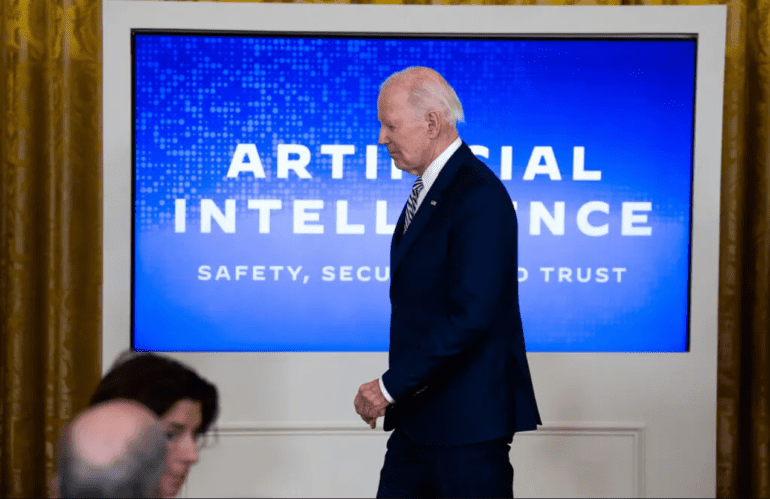TL;DR:
- The White House has issued a sweeping executive order aimed at regulating the rapidly evolving field of artificial intelligence (AI).
- The executive order strikes a balance between allowing AI development to continue and imposing modest rules on the industry.
- AI safety advocates will appreciate new requirements for companies developing powerful AI systems, including safety testing and government notification.
- Cloud providers such as Microsoft, Google, and Amazon must disclose information about their foreign AI customers.
- Federal agencies are directed to prevent AI algorithms from exacerbating bias and discrimination in various domains, and guidelines for watermarking A.I.-generated content will be developed.
- AI companies are relieved that the order does not require a licensing system for large AI models or force them to withdraw products or disclose sensitive information.
- The order aims to streamline immigration processes to attract specialized AI talent.
- It represents the most comprehensive regulatory framework for AI in the absence of comprehensive legislation.
Main AI News:
The conundrum of regulating artificial intelligence, a technological marvel with the potential to both empower and endanger, has baffled governments worldwide. Its pervasive influence across economic sectors, coupled with its rapid evolution, presents a formidable challenge for policymakers and experts alike.
Inadequate regulation risks overlooking potential hazards and misuse, while hasty rule-making can stifle innovation, a fate the European Union grappled with when it released its AI Act in 2021, just before a wave of new generative AI tools rendered much of the legislation outdated.
The White House has now taken center stage in this complex dance by announcing a comprehensive executive order designed to govern the ever-accelerating realm of artificial intelligence. The Biden administration, like its counterparts, faced mounting pressure to address AI’s impact following the public’s awakening to generative AI applications.
This executive order charts a middle course, allowing AI development to proceed largely unhindered while imposing some modest rules and signaling a keen federal interest in the industry’s trajectory. It signals a stark departure from the laissez-faire approach that characterized the growth of social media for over a decade.
The extensive executive order, exceeding 100 pages, caters to a diverse spectrum of stakeholders. AI safety advocates, who have long voiced concerns about AI’s existential risks, will applaud the order’s imposition of new requirements on companies developing powerful AI systems.
Notably, companies creating the largest AI systems must notify the government and share safety testing results before releasing their models to the public. These requirements will be enforced through the Defense Production Act, granting the president authority to compel compliance in the name of national security.
Furthermore, the order mandates that cloud providers, including industry giants like Microsoft, Google, and Amazon, disclose information about their foreign customers. It tasks the National Institute of Standards and Technology with devising standardized tests to evaluate AI model performance and safety.
For AI ethics advocates concerned with short-term issues like bias and discrimination, the order directs federal agencies to take measures to prevent AI algorithms from exacerbating such problems in housing, federal benefit programs, and the criminal justice system. Additionally, it charges the Commerce Department with developing guidance for watermarking A.I.-generated content, aiming to counter the spread of A.I.-generated misinformation.
Interestingly, AI companies targeted by these regulations expressed relief that the order stopped short of imposing a licensing requirement for training large AI models. It refrains from forcing companies to withdraw existing products or disclose sensitive information like model sizes and training methodologies. Copyrighted data’s role in training AI models remains untouched.
Tech companies will also benefit from the order’s efforts to ease immigration restrictions and streamline visa processes for AI specialists, contributing to a national “AI talent surge.”
While not everyone will be entirely satisfied, the executive order strikes a delicate balance between pragmatism and caution. In the absence of comprehensive AI legislation, it represents the clearest guardrails for the foreseeable future.
Nevertheless, further attempts to regulate AI are on the horizon, notably in the European Union and the United Kingdom. The White House’s executive order serves as a clear indication of its intent to act swiftly. The looming question remains whether AI itself will continue to outpace regulatory efforts.
Conclusion:
The White House’s executive order seeks to strike a balance between nurturing AI innovation and safeguarding against potential risks. It provides a structured framework that addresses key concerns in the AI industry, signaling the government’s commitment to overseeing this rapidly evolving market. Companies should prepare for increased scrutiny and reporting requirements while benefiting from streamlined talent acquisition processes.

